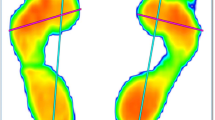Abstract
The objective of the present study was to compare changes in plantar foot pressure parameters during quiet standing between patients with adolescent idiopatic scoliosis (AIS) and healthy subjects. Twenty-one volunteers (AIS, n=10; healthy, n=11) were recruited for a simple blinded study. Using X-ray imaging, Cobb’s angle and pelvic height were measured in the monitor. Using a force plate, plantar foot pressure parameters were measured during quiet standing. In the analysis of Cobb’s angle and pelvic height, the AIS patients showed a significant increase compared to the healthy subjects. Furthermore, the regional plantar foot pressure of the AIS patients was significantly increased compared to that of the healthy subjects. These results suggest that AIS affects plantar foot pressure parameters. Therefore, the present data may contribute to our understanding of the body alignment of patients undergoing orthopedic physiotherapy.
Similar content being viewed by others
References
Lee, J. U. et al. Analysis of plantar foot pressure during the non-crutch, two-point, and four-point crutch gait performed by healthy volunteers. J. Phys. Ther. Sci. 23, 489–493 (2011).
Lee, J. U. et al. Posture analysis of various types of crutch gait of healthy volunteers. J. Phys. Ther. Sci. 25, 453–458 (2013).
Teichtahl, A. J. et al. The associations between body and knee height measurements and knee joint structure in an asymptomatic cohort. BMC Musculoskelet. Disord. 13, 19 (2012).
Weinstein, S. L. et al. Adolescent idiopathic scoliosis. Lancet 371, 1527–1537 (2008).
Kesling, K. L. & Reinker, K. A. Scoliosis in twins. A meta-analysis of the literature and report of six cases. Spine 22, 2009–2014 (1997).
Parent, S., Newton, P. O. & Wenger, D. R. Adolescent idiopathic scoliosis: etiology, anatomy, natural history, and bracing. Instr. Course Lect. 54, 529–536 (2005).
Odermatt, D. et al. Electromyography of scoliotic patients treated with a brace. J. Orthop. Res. 21, 931–936 (2003).
Cheung, J. et al. Geometric and electromyographic assessments in the evaluation of curve progression in idiopathic scoliosis. Spine 31, 322–329 (2006).
Rai, D. V. & Aggarwal, L. M. The study of plantar pressure distribution in normal and pathological foot. Pol. J. Med. Phys. Eng. 12, 25–34 (2006).
Schmiegel, A. et al. Assessment of foot impairment in rheumatoid arthritis patients by dynamic pedobarography. Gait Posture 27, 110–114 (2008).
Rao, S., Saltzman, C. L. & Yack, H. J. Relationships between segmental foot mobility and plantar loading in individuals with and without diabetes and neuropathy. Gait Posture 31, 251–255 (2010).
Hessert, M. J. et al. Foot pressure distribution during walking in young and old adults. BMC Geriatrics 5, 8 (2005).
Ramanathan, A. K. et al. Repeatability of the Pedar-X in-shoe pressure measuring system. Foot Ankle Surg. 16, 70–73 (2010).
McPoil, T. G. & Cornwall, M. W. Variability of the center of pressure pattern integral during walking. J. Am. Podiatr. Med. Assoc. 88, 259–267 (1998).
Wong, L. et al. Effect of foot morphology on centerof-pressure excursion during barefoot walking. J. Am. Podiatr. Med. Assoc. 98, 112–117 (2008).
De Cock, A. et al. The trajectory of the centre of pressure during barefoot running as a potential measure for foot function. Gait Posture 27, 669–675 (2008).
Hsue, B. J., Miller, F. & Su, F. C. The dynamic balance of the children with cerebral palsy and typical developing during gait Part II: Instantaneous velocity and acceleration of COM and COP and their relationship. Gait Posture 29, 471–476 (2009).
Melis, E. H. et al. Analysis of assisted-gait characteristics in persons with incomplete spinal cord injury. Spinal Cord. 37, 430–439 (1999).
Minamisawa, T., Takakura, K. & Yamaguchi, T. Detrended fluctuation analysis of temporal variation of the center of pressure during quiet standing in parkinsonian patients. J. Phys. Ther. Sci. 21, 287–292 (2009).
Bruce, W. D. & Stevens, P. M. Surgical correction of miserable malalignment syndrome. J. Pediatr. Orthop. 24, 392–396 (2004).
Harris, J. H. Jr. Malalignment: signs and significance. Eur. J. Radiol. 42, 92–99 (2002).
Cassar-Pullicino, V. N. & Eisenstein, S. M. Imaging in scoliosis: what, why and how? Clin. Radiol. 57, 543–562 (2002).
Burwell, R. G. Aetiology of idiopathic scoliosis: current concepts. Pediatr. Rehabil. 6, 137–170 (2003).
Stehbens, W. E. Pathogenesis of idiopathic scoliosis revisited. Exp. Mol. Pathol. 74, 49–60 (2003).
Bryant, A., Tinley, P. & Singer, K. Plantar pressure distribution in normal, hallux valgus and hallux limitus feet. Foot 9, 115–119 (1999).
Lee, J. U. et al. Increase of myoglobin in rat gastrocnemius muscles with immobilization-induced atrophy. J. Phys. Ther. Sci. 25, 1617–1620 (2013).
Kim, J. H. et al. The effect of standing posture-enhancing exercise on Parkinson’s disease patients’ turning around motion. J. Phys. Ther. Sci. 24, 1047–1050 (2012).
Noh, J. W., Kim, J. H. & Kim, J. Somatotype analysis of Korean wrestling athletes compared with non-athletes for sports health sciences. Toxicol. Environ. Health Sci. 5, 163–168 (2013).
Noh, J. W., Kim, J. H. & Kim, J. Somatotype analysis of elite taekwondo athletes compared to non-athletes for sports health sciences. Toxicol. Environ. Health Sci. 5, 189–196 (2013).
Noh, J. W. et al. Somatotype analysis of elite boxing athletes compared with nonathletes for sports physiotherapy. J. Phys. Ther. Sci. (in press).
Author information
Authors and Affiliations
Corresponding author
Additional information
These authors contributed equally to this work.
Rights and permissions
About this article
Cite this article
Lee, JU., Kim, MY. & Kim, J. Comparison of static plantar foot pressure between healthy subjects and patients with adolescent idiopathic scoliosis. Toxicol. Environ. Health Sci. 6, 127–132 (2014). https://doi.org/10.1007/s13530-014-0197-6
Received:
Revised:
Accepted:
Published:
Issue Date:
DOI: https://doi.org/10.1007/s13530-014-0197-6




